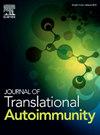Afucosylated IgG in idiopathic nephrotic syndrome patients with anti-nephrin autoantibodies correlate with disease activity
IF 3.6
Q2 IMMUNOLOGY
引用次数: 0
Abstract
Background
Idiopathic nephrotic syndrome (INS) is a glomerular disorder characterized by podocyte injury and proteinuria. Emerging evidence suggests that anti-nephrin autoantibodies (Abs) may contribute to disease pathogenesis in a subset of INS patients. Variation in techniques for detecting anti-nephrin Abs and lack of urinary data contribute to uncertainties of results.
While reduced IgG fucosylation is known to enhance antibody-dependent cellular cytotoxicity in non-INS autoimmune diseases, its role in modulating anti-nephrin autoantibody function and disease severity in INS remains unexplored.
Methods
We studied serum and urine of pediatric and young adult patients with biopsy-proven focal segmental glomerulosclerosis (FSGS) or minimal change disease (MCD) with different disease activity (proteinuria + vs proteinuria-). Anti-nephrin autoantibodies were evaluated with either conventional ELISA and immunoprecipitation using recombinant full-length extracellular domain of FLAG tagged human nephrin. Aleuria Aurantia Lectin (AAL) and Ulex Europaeus Agglutinin I (UEA-I) Lectins assessed IgG autoantibody fucosylation.
Results
Anti-nephrin autoantibodies were detected in serum of 11 % of FSGS and 15 % of MCD patients, with a higher prevalence among those with nephrotic-range proteinuria. These autoantibodies were absent in healthy controls as well as in patients with primary membranous nephropathy and class V lupus nephritis. Autoantibody titers correlated with disease activity, decreasing during remission. Immunoprecipitation confirmed results obtained with ELISA. In a subset of anti-nephrin positive patients, the autoantibodies were also detected in urine. Circulating anti-nephrin autoantibodies showed significantly reduced antennary and core fucosylation of IgG.
Conclusions
Our findings confirmed the significance of anti-nephrin autoantibodies as markers of active disease in a small subset of INS patients and showed their presence in urine. ELISA and Immunoprecipitation results correlated. Molecular studies showed that altered IgG fucosylation may contribute to immune-mediated podocyte injury. These insights provide potential biomarkers for disease monitoring and therapeutic targets in INS.
特发性肾病综合征患者的抗肾素自身抗体与疾病活动性相关
didiopathic nephrotic syndrome (INS)是一种以足细胞损伤和蛋白尿为特征的肾小球疾病。新出现的证据表明,抗肾素自身抗体(Abs)可能有助于部分INS患者的疾病发病机制。检测抗肾素抗体的技术差异和尿液数据的缺乏导致了结果的不确定性。虽然已知在非INS自身免疫性疾病中,IgG聚焦化降低可增强抗体依赖的细胞毒性,但其在INS中调节抗肾素自身抗体功能和疾病严重程度的作用仍未被探索。方法:研究活检证实的局灶节段性肾小球硬化症(FSGS)或微小改变病(MCD)患儿和青年成人不同疾病活动性(蛋白尿+与蛋白尿-)的血清和尿液。采用常规ELISA法和重组人肾素全长胞外结构域免疫沉淀法检测抗肾素自身抗体。白念珠菌凝集素(AAL)和欧paeus凝集素I (UEA-I)凝集素评估IgG自身抗体聚焦。结果11%的FSGS患者和15%的MCD患者血清中检测到抗肾素自身抗体,其中肾范围蛋白尿患者的患病率更高。这些自身抗体在健康对照者以及原发性膜性肾病和V型狼疮肾炎患者中均不存在。自身抗体滴度与疾病活动相关,在缓解期间降低。免疫沉淀证实了ELISA获得的结果。在一部分抗肾素阳性患者中,尿中也检测到自身抗体。循环抗肾素自身抗体显示IgG的触角和核心聚焦显著降低。结论sour的发现证实了抗肾素自身抗体在小部分INS患者中作为活动性疾病的标志物的意义,并且在尿液中显示出它们的存在。ELISA与免疫沉淀结果相关。分子研究表明,IgG聚焦化的改变可能导致免疫介导的足细胞损伤。这些见解为INS的疾病监测和治疗靶点提供了潜在的生物标志物。
本文章由计算机程序翻译,如有差异,请以英文原文为准。
求助全文
约1分钟内获得全文
求助全文
来源期刊

Journal of Translational Autoimmunity
Medicine-Immunology and Allergy
CiteScore
7.80
自引率
2.60%
发文量
33
审稿时长
55 days
 求助内容:
求助内容: 应助结果提醒方式:
应助结果提醒方式:


